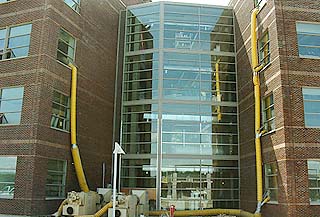|
Subscribe / Renew |
|
|
Contact Us |
|
| ► Subscribe to our Free Weekly Newsletter | |
| home | Welcome, sign in or click here to subscribe. | login |
Construction
| |
 |
October 9, 2003
Construction drying keeps moisture at bay
Munters

Photo courtesy of Munters
Humidity-control machines pump dry air into the Cascadia Community College building in this 2000 photo. The dry air offers a useful way to draw out moisture from drying surfaces.
|
A unique approach to solving moisture problems during construction is speeding projects around Puget Sound.
Construction drying, which uses state-of-the-art drying technology to remove moisture and control humidity, saves time, money and mold claim headaches for contractors.
The method provides a cost-effective means of speeding work and achieving project milestones while avoiding costly liquidated damages and potential mold claims due to moisture problems during construction.
Construction drying uses desiccant dehumidification instead of dangerous propane heaters or the building’s permanent HVAC system.
Propane heaters have been proven to add excessive amounts of moisture and contaminants to the air when operating inside a building under construction.
Conventional HVAC systems are not designed to dry out construction-related moisture. The moisture load from wet materials is simply too large and the drying task too complex for systems that are intended for comfort air conditioning.
Desiccant dehumidifiers
Desiccant dehumidifiers continuously replace humid air inside the building with air that has been dehumidified. Desiccant dehumidifiers contain a desiccant wheel, which is made up of silica gel bonded to a fast-heating substrate, such as fiberglass or paper.
The wheel looks like a finely meshed honeycomb material with many small flutes. The flutes, like the fins on a coil, force the air path evenly along the concentrated desiccant. The desiccant attracts water molecules through its tiny pores, soaking up moisture like a sponge.
As the rotor turns, three quarters of the desiccant wheel cycles through the process inlet path that creates the dry air, while the wheel’s remaining quarter passes through a regeneration chamber.
Regeneration is accomplished by passing extremely hot air — around 250 degrees Fahrenheit — through the wheel and into an exhaust. The hot air provides a greater attraction for water molecules than the desiccant, and the wheel is thus regenerated.
The hot air may be generated using a number of different strategies. These strategies enable the equipment to meet the various power limitations often found on construction sites.
Once the dry air has been generated, the dehumidifier’s built-in blower pumps the air through a plastic tube (perforated on site) that continuously dispenses dry, clean, warm air throughout the construction space.
This extremely dry air has a low vapor pressure. As a result, the dry air attracts moisture molecules from wet surfaces, allowing them to dry more quickly. Surfaces often include freshly sprayed fireproofing, joint compound, concrete slabs, floor leveling products, concrete block walls and stored building materials.
Water-laden fireproofing dries slowly inside closed areas when it is applied. Often, the humidity that results can encourage mold contamination. Desiccant dehumidifiers blow super-dry air that absorbs the moisture and expels it from the building.
Joint compound dry times can be reduced to 11-12 hours uniformly throughout a 350,000-cubic-foot floor.
Preparing floors
Concrete slabs can meet flooring manufacturers’ moisture-content specifications for coating or floor covering applications twice as fast as normally expected.
Finished flooring products such as vinyl composite tile and fiber-backed carpet are applied with adhesives extremely sensitive to moisture.
Desiccant dehumidification removes moisture from concrete, allowing installers to meet manufacturers’ specifications and protect against premature flooring failures.
Drying the air stops hardwood flooring and trim from absorbing moisture and warping. With desiccant dehumidification, valuable millwork stays true and floors can be installed under ideal conditions.
Large amounts of water can be trapped in concrete block walls. Desiccant drying will lower the air’s vapor pressure, drawing out moisture from deep within the walls to prevent the insulation from absorbing moisture before the wallboard is installed.
Building materials are also stored in a controlled environment with an ambient relative humidity level that helps protect their integrity and prevent potential mold growth from occurring at the surface of that material.
Desiccant dehumidification at Seattle’s Opus at Union Station project allowed 11-12 hour dry times on joint compound, and reduced the moisture content of the concrete slabs prior to the finish flooring installation. Ambient relative humidity levels were also kept at a level unlikely to support mold growth, and conditions were monitored and recorded throughout the drying process.
Similar results were achieved at Turner Construction’s Public Health Sciences Building at the Fred Hutchinson Cancer Research Center, Clark Construction’s Sea-Tac International Airport expansion project, Hoffman Construction’s Tacoma Art Museum project and Skanska’s Helix Project for Amgen.
Chris Cortinas is construction drying account manager for Munters Moisture Control Services Washington and Western Canada Division. He can be reached by e-mail at chris_cortinas@munters.com.
Other Stories:
- Time to get serious about moisture
- Precautions during construction will save headaches later
- Consider your options for exterior cladding


